My skincare rituals don’t go much beyond washing the face with soap. But, at the same time, I know many people with more sophisticated skin care needs. They navigate between dozens of bottles and follow specific instructions to get to their happy healthy places. And it can be tricky and daunting. And no, I’m not being sarcastic at all.
If you want to create a skincare app to make people healthier and happier, here’s a blog to help you do that.
Top Takeaways:
- The most lucrative directions for skincare app development include implementing AI/ML and IoT technologies for automatically scanning and analyzing skin features.
- It’s hard to imagine building a skincare app without creating a content management system (CMS) for populating the software with educational content and beauty products.
Table of Contents:
- Skin Care Apps Market Overview
- Top 3 Skincare Apps
- Why Should You Create a Skincare App
- Features of a Skincare App
- Skincare App Monetization Models
- Tech Stack Needed to Build an App for Skin Care
- 6 Steps to Develop a Skincare App
- Skincare Application Development Cost
- Topflight Apps’ Experience in Building a Skincare App
Skin Care Apps Market Overview 150
The good news is the skincare market in the U.S. counts in billions of dollars.
 The even better news is that mobile apps make up just a teeny-tiny fraction of this market. So there are plenty of opportunities to disrupt the space. The most popular applications help customers to fulfill one of these use cases:
The even better news is that mobile apps make up just a teeny-tiny fraction of this market. So there are plenty of opportunities to disrupt the space. The most popular applications help customers to fulfill one of these use cases:
- scan the face and get personalized tips
- simulate customer appearance in the distant future
- explain ingredients used in cosmetic products
- allow virtually testing beauty products
- walk users through a skincare routine
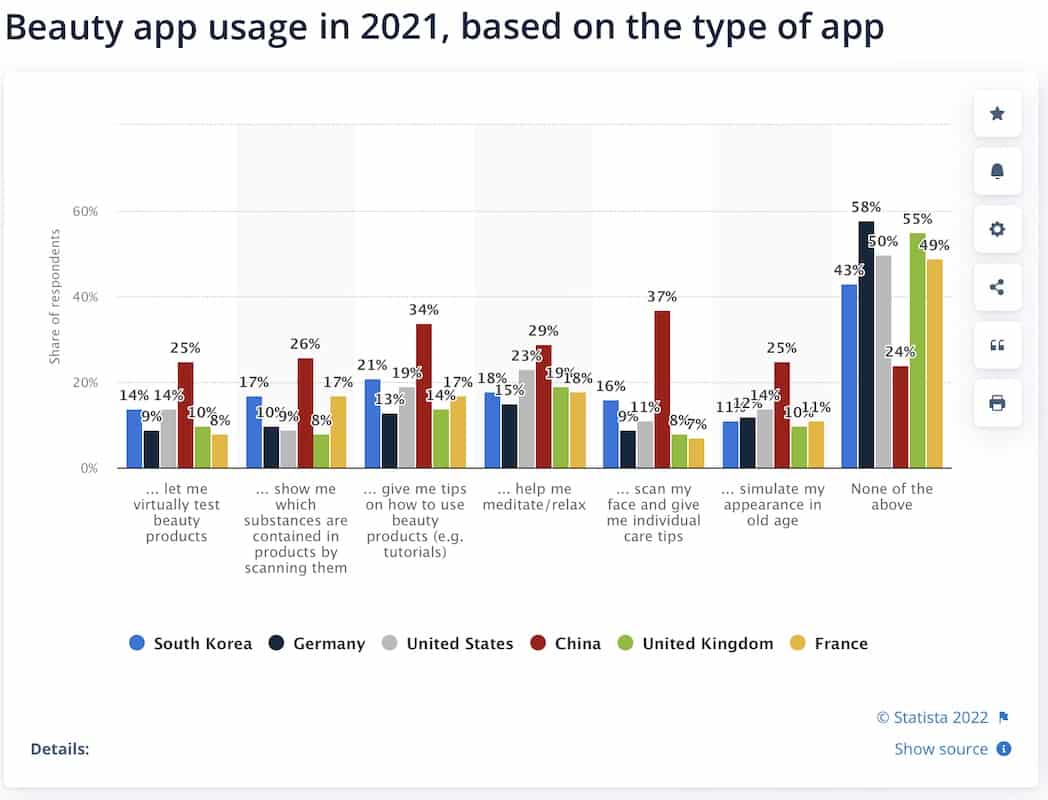 Why do I think that your skincare app won’t compete with hundreds of other popular apps? After I combed through 150 top healthcare and fitness apps (in the paid, free, and top-grossing categories), I only found 2 relevant apps — Skincare Routine and FaceJoy.
Why do I think that your skincare app won’t compete with hundreds of other popular apps? After I combed through 150 top healthcare and fitness apps (in the paid, free, and top-grossing categories), I only found 2 relevant apps — Skincare Routine and FaceJoy.

 Skincare Routine (#57 in Top Paid) has been out since 2018 and generates about 5K in downloads and revenue per month. And the app for face yoga exercises (#94 in Top Free and #90 in Top Grossing) has rocked on since 2021, generating 200K in downloads and $300K in revenue.
Skincare Routine (#57 in Top Paid) has been out since 2018 and generates about 5K in downloads and revenue per month. And the app for face yoga exercises (#94 in Top Free and #90 in Top Grossing) has rocked on since 2021, generating 200K in downloads and $300K in revenue.
You May Also Be Interested: How to Build a Yoga App
So, is there no competition at all? Not at all. You have well-known brands like L’Oreal entering the scene, trying to win over customers with their mobile apps. Although, as often is the case with incumbents, the user experience leaves much to be desired:
 Apart from a few prominent players like L’Oreal, there are maybe a couple dozen other skincare apps that you’ll compete with. We can divide them into these categories:
Apart from a few prominent players like L’Oreal, there are maybe a couple dozen other skincare apps that you’ll compete with. We can divide them into these categories:
| Skincare routines | Face yogas + acne | Teledermatology | Reference |
|
|
|
|
As you can see, the competition is not particularly tense. Please note that we’ll focus on the skincare routine apps in this blog (not makeup apps) since they usually provide more versatile features and have higher ratings.
Top 3 Skincare Apps
| Skincare Routine | Good Face | Skin Rocks | |
| Founded | August 2018 | December 2020 | June 2022 |
| User reviews | |||
| Notable features |
|
|
|
| Monetization Strategy | paid app, $3.99 | sales commission | sales commission |
Why Should You Create a Skincare App
The most common path to creating a skincare app is selling skincare products or providing cosmetic dermatology services.
Related: Explore our Dermatology App Development Services
A mobile skincare app can become the hub for educating your customers, consulting them on their skincare needs, and providing them with tools and products to improve their skin health.
Let’s jot down the benefits for customers:
- on-demand hyper-personalized skincare routines
- remote consultations
- convenient shopping experience
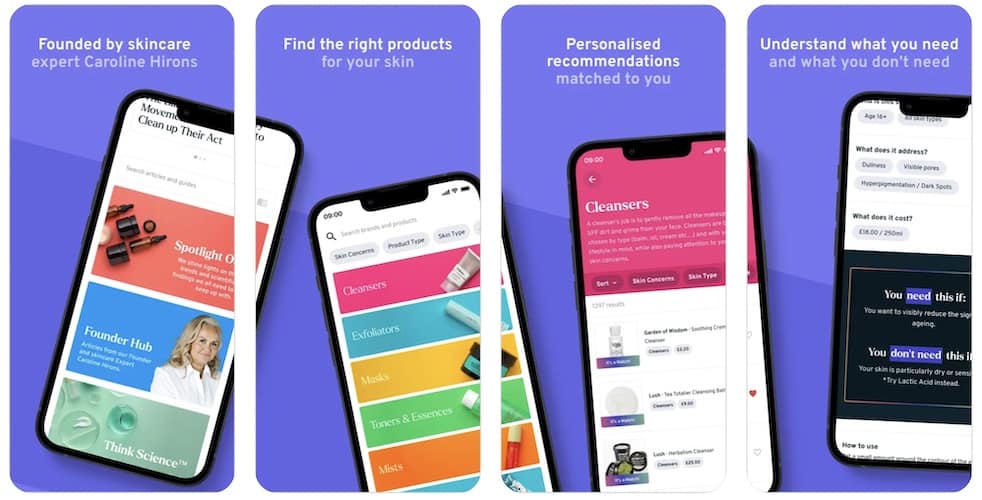 As for professionals, the advantages they get with a skincare app are pretty obvious too:
As for professionals, the advantages they get with a skincare app are pretty obvious too:
- marketing and e-commerce channel for selling skincare services and products
- serving customers wherever they are on a subscription basis
- online scheduling
Features of a Skincare App
What are the most essential features of skincare software? Here’s an exhaustive list of features you might consider if you plan to develop a skincare routine app. Granted, you don’t have to include all possible options in your solution, but here’s something to choose from.
Sing-up & onboarding
Before asking users for credentials, it’s an excellent idea to include a mini questionnaire or other triggers to engage the user, apart from a typical tutorial-based welcome.
Diary + skincare routine
Logs of morning and evening skincare routines are often the core option in such applications helping users track their skin condition, mood, product dosage, etc.
Users may also want to track their sleep, diet, stress, and water intake.
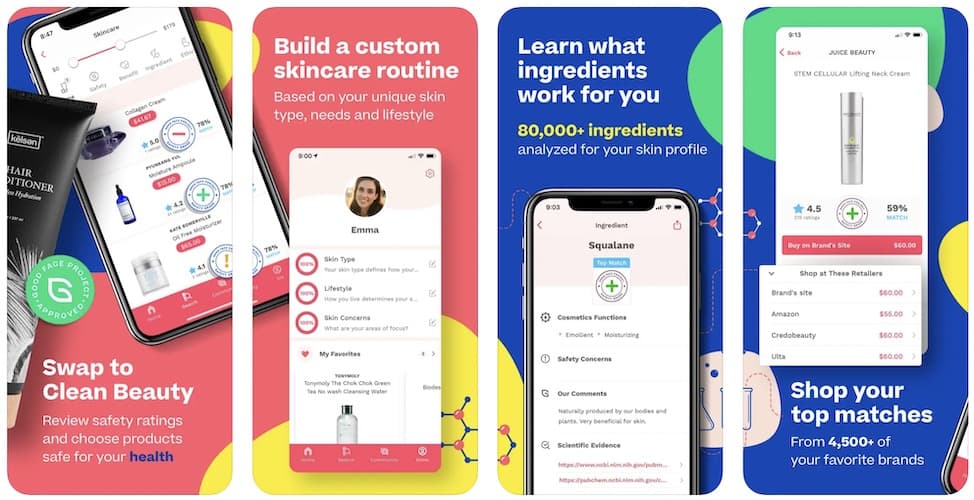
Read our guide on how to make a nutrition app
Ecommerce
Ordering beauty products specifically selected for you from the couch is a pleasant experience, even if it’s just a link to Amazon. Consider adding price comparisons across different stores and user reviews.
Reminders and timers
Notifications keep customers returning to the app to follow the procedure or track their progress. And timers are handy when going through time-sensitive procedures. By the way, voice control doesn’t sound like a bad idea because our hands are often a mess amid a skincare ritual.
Educational information
A skincare app can provide tons of helpful info on ingredients, appliance techniques, usage of conflicting products, and so much more.
AI for skin scoring
Machine learning can add a whole new dimension to skincare. For example, allowing users to take selfies and analyze them against a large dataset can provide insights into better skincare practices.
Related: Machine Learning App Development Guide
Naturally, the AI feature can’t work without integrating the phone’s camera and a stock photo app. You can spice this option by adding overlay filters to show different products’ negative and positive effects or visualize the sun’s impact (wrinkles, spots, etc.).
Related: Computer Vision in Healthcare Applications
Voice control
As mentioned, stopping timers, marking steps of a regimen complete, and so many other things are easier to manage with voice commands.
Personalization
Beauty routine is very personal, and so personalization should really permeate all aspects of your app:
- favorite ingredients, allergies, skin type, lifestyle
- instant tips based on diary entries
- adding your own products
- wish lists
As you understand, that’s just the tip of the iceberg to get you started.
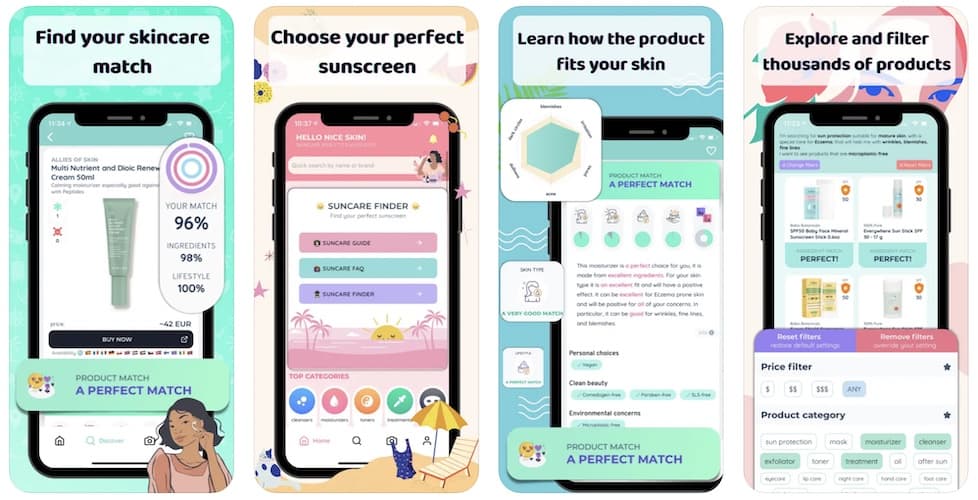
Ever-updating database of products
It’s critical to maintain a database of products with all relevant info, e.g., expiration dates, ingredients, etc. So you’ll probably end up developing a web scraper working with select websites to keep the database updated.
Telemedicine
Suppose you want to start a teledermatology application. In that case, you’ll have to include video consultations with skin care professionals, dermatologists, licensed estheticians, or beauty experts. This can also be as simple as a live chat with photo sharing.
Check out our teledermedicine app development services.
Filters and smart search
This option can be part of the shopping experience or encompass everything your app offers users, for instance, beauty regimens, educational materials, etc.
Community-building features
Allowing users to add/invite friends, share their progress, or follow other users’ routines will help create a solid community around beauty apps.
Content management system
On the admin side, we’ll need a CMS to keep the app’s content fresh and to manage users and their subscriptions.
Innovative killer features
Finally, innovate. What option will drive the most adoption? Will it be AI photo analysis, fancy AR effects, an IoT integration with a novel skin scanner, or something else?
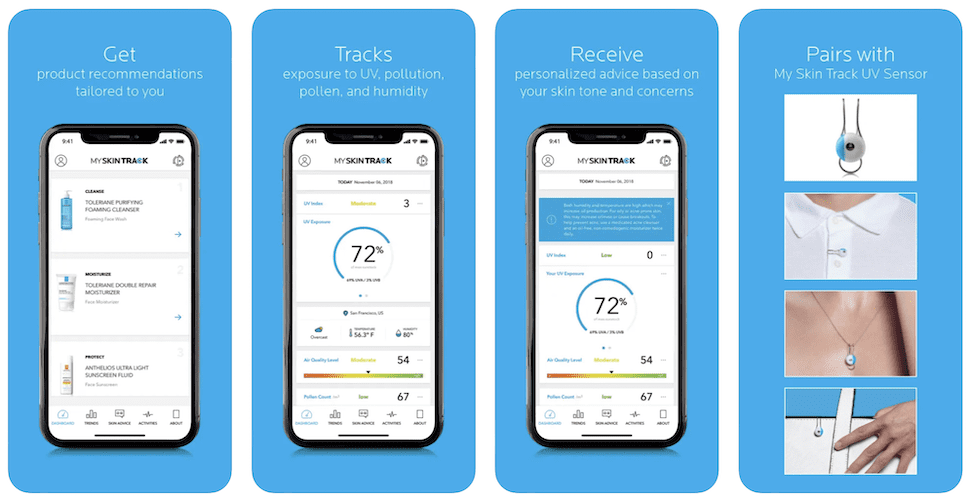 Here’s an idea. Your customers can create and share their own routines and progress. This feature can help with early adoption, provided you onboard a few influencers.
Here’s an idea. Your customers can create and share their own routines and progress. This feature can help with early adoption, provided you onboard a few influencers.
Skincare App Monetization Models
Healthy skin comes with a cost. The most effective models for monetizing skincare apps include:
- subscriptions
- revenue share or commissions
You could also make the app a paid download or run ads inside. However, business owners must prioritize their monetization strategies before they start skincare apps.
Imagine that the primary revenue stream is advertising. Choosing the most effective ad formats and integrating them into the app naturally will be critical to its success.
On the other hand, a tiered approach with subscriptions or a sales commission is the most future-proof monetization strategy. For example, how about adding gamification so that users get bonuses for their engagement? Such an approach can potentially drive more sales and attract more customers.
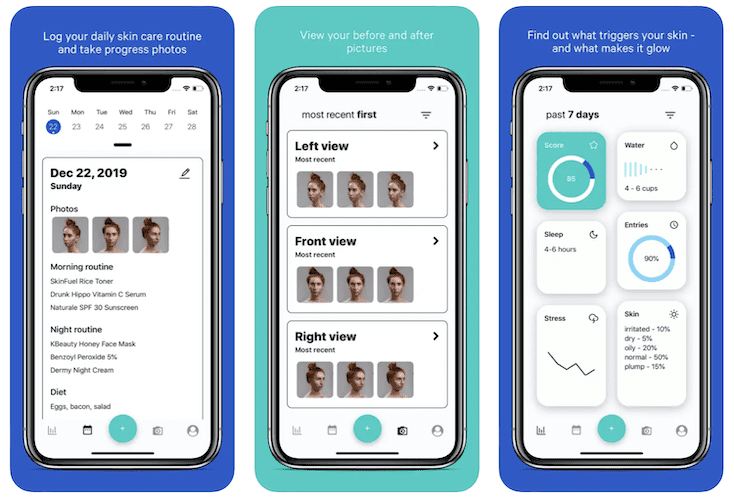
Tech Stack Needed to Build an App for Skin Care
Developing an app to create a skin care routine is a pretty straightforward process from the technology perspective. We’d recommend using a cross-platform development tool like React Native or Flutter to build the mobile apps and Firebase/Node on the back end.
Alternatively, if you plan to deploy machine learning algorithms, we might need to fire up an AWS or Google Cloud environment with an appropriate AI service.
Related: How to Choose a Tech Stack?
6 Steps to Develop a Skincare App
Ok, so what exactly does skincare application development entail? What are the steps? Let’s list all the main steps here and then review them one by one:
- Discovery
- Proof of concept (optional; if AI underpins the core feature)
- Prototyping
- Development
- Deployment
- Maintenance
Step #1: Discovery
We start to build a skin care app by researching the target audience, creating a roadmap, and deciding on leading technological components. Even though skin care applications seemingly target mostly female demographics, there still needs to be a focus on a specific niche. Whom will your application target?
- teenagers/grown-ups/senior groups of customers
- stay-at-home moms/male models/business women
- teenage boys/actors, etc.
After learning about the unique needs of your target demo, you can draw up the app’s strategic roadmap and pick one or two cornerstone features for launching a minimal viable product (MVP).
Usually, MVP features need to align with ROI goals so that we work on the functionality that impacts the bottom line the most.
Step #2: Proof of concept (optional)
A proof of concept is only necessary to prove that AI functionality can deliver tangible value to customers. Like if you plan to run algorithms analyzing the skin and providing tips, you need to create an ML model and test it. Fortunately, this step doesn’t involve any UI development.
Step #3: Prototyping
Prototyping is the next logical step to verify your idea, this time with customers. Note that prototyping is not how we design an app for skincare. Instead, we focus on the key screens and interactions during the rapid prototyping phase.
The outcome is an interactive prototype that users can click through in a web browser or mobile device. The prototype emulates the app’s behavior, and after evaluating users’ reactions, we can improve our solution without coding.
This matters because coding is the most expensive part of any software development project.
Step #4: Development
Development is often understood as simply coding. However, in reality, we have quite a few things going on during this step:
- UX/UI design (everything that didn’t go into a prototype still needs to be designed)
- front-end development (bringing the UI into software flesh)
- back-end development (setting up databases, APIs, and everything else powering the app’s logic)
- testing — an ongoing process to weed out bugs
- DevOps activities — an automated bridge from code to working software
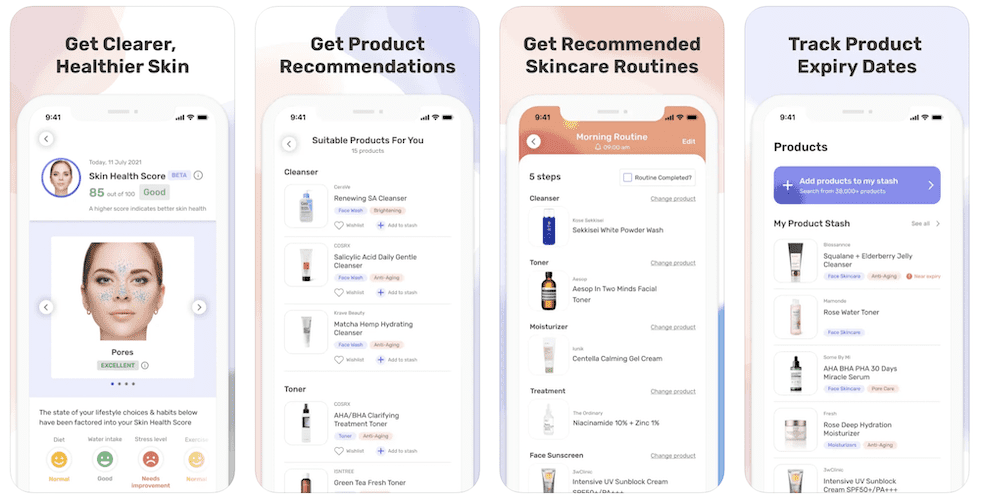 As you can see, it takes a multidisciplinary team to create a face care routine app. As UX engineers, developers, testers, and DevOps specialists begin to work on the project, they launch an agile cycle, so to speak.
As you can see, it takes a multidisciplinary team to create a face care routine app. As UX engineers, developers, testers, and DevOps specialists begin to work on the project, they launch an agile cycle, so to speak.
Related: DevOps Implementation Guide
That means that they proceed to make a skincare routine app by releasing features in small batches — usually every two weeks or so. Then, once all critical components for the MVP are ready, they will release the solution and continue building the rest options from a backlog.
Related: Agile App Development Guide
Step #5: Deployment
The deployment includes updating mobile apps to the App Store and Google Play and switching to a tested production version of the product in the cloud. Think of the cloud as the app’s brains—it must always be available and optimized for a mass influx of users.
Note that deployment will take place multiple times, and given you have DevOps practices set up, the deployment mechanism will take care of releases automatically. Such an approach guarantees that developers spend their time working on new functionality rather than wasting time on manual code manipulations (necessary for turning code into actual software).
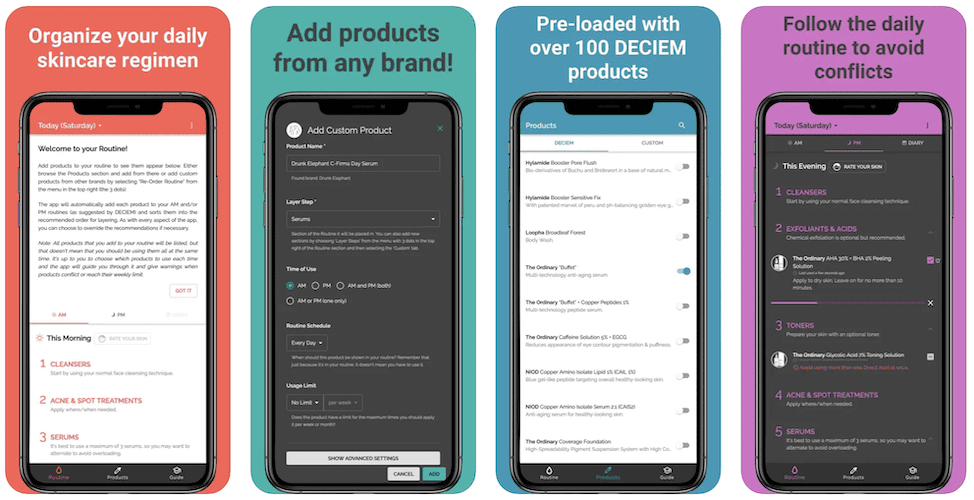
Step #6: Maintenance
You’d think the deployment step would be final — the application is available to customers. So what’s there to be done? Well, it’s the most fun part because now you get to see how customers will interact with your skincare app.
Ideally, at this (also ongoing stage), you monitor the software performance, automatically logging any technical issues in the app and on the server side. In addition, you can monitor user engagement patterns in the app, looking for ways to improve the ease of use and planning future features.
Skincare Application Development Cost
Depending on its complexity, it may take somewhere between $60,000 and $90,000 or $110,000 and $160,000 to develop a skin care routine app. The higher-end pricing would include the development of such features as AI, AR, or IoT integrations.
Topflight Apps’ Experience in Building a Skincare App
We know a thing or two about how to make skin care apps at Topflight Apps because we worked on one exciting dermatology app. Long story short, our healthcare app development company was commissioned to build a dermatology app that provides customers with skincare treatment routines and educational material based on their DNA.
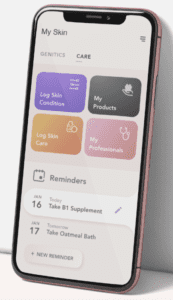
The company used to issue pdf reports which failed as a patient engagement tool. Therefore, we designed an inspiring user experience for mobile devices. This scalable mobile application provides not only a skin diary but also includes teledermatology options if customers need a live consultation.
Related Article: How to Increase Patient Engagement?
Take a closer look at this skincare app case study; there’s nothing like this on the market right now.
If you have more questions about developing a dermatology or skincare app, reach out to our experts today.
[This blog was originally published on 8/10/2022 but has been updated for more recent content]
Frequently Asked Questions
What best practices can you recommend for creating a skincare app?
Find a way to demonstrate the value your app provides during onboarding; keep users engaged with personalized notifications and content; include social networking options to get virality.
What are the best monetization options for such applications?
Sales commissions and subscriptions
If you could name one thing to be obsessed about when working on a dermatology app, what would it be?
Top-notch design. And you nail that by creating a rapid prototype first.
Is there a particular tech stack I should stick to?
Anything your team is comfortable with, as long as that translates into a smooth user experience. Also, take a closer look at AI/ML technologies that process all data locally on mobile devices without uploading it to the cloud.
How long does it take to build a skincare app?
Between 4 and 6 months.

